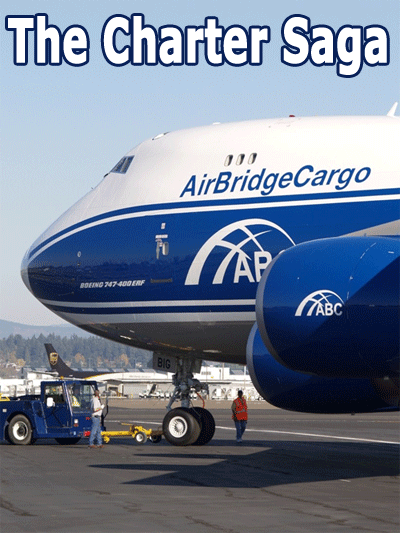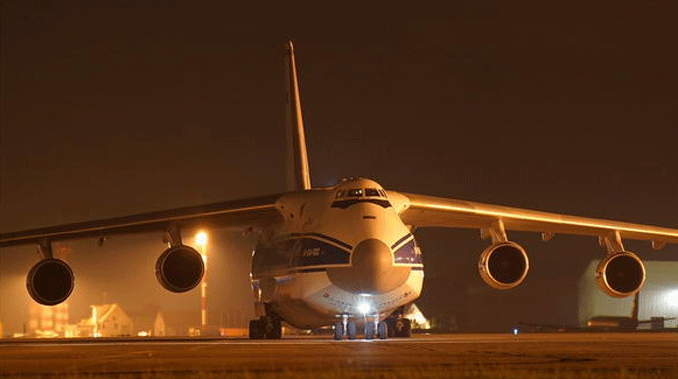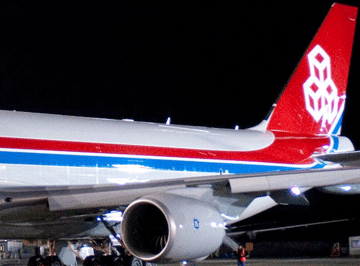 “That
is not a saga, it’s a gas: mellifluous and malodorous.” “That
is not a saga, it’s a gas: mellifluous and malodorous.”
The great WWI American ace and later airline
pioneer Ralph O’Neill once said those words to me after reading
a book about Pan Am titled An American Saga.
Ever since then, I have been quite careful
about using the word “saga” anywhere in case the usage warrants
turning the word around.
The air-charter market provides a significant
service often in world headlines in times of crises: think of the courageous
and daring air cargo sagas that occurred between Burma and Berlin in WWII,
and the Ebola outbreak of 2014.
One could argue that air charter is the
single service of the cargo saga that launched the air cargo business
as an industry in the first place.
As our senior contributing editor, 101 year
old Richard Malkin, the first air cargo journalist in the world once told
me:
“I flew in and out of Berlin in 1948
aboard several aircraft as military air charter operations kept the city
alive during the Soviet blockade.
“Those flights ignited my imagination
while writing of the great capability and future possibilities of air
cargo.
“I was hooked and have been writing
about air cargo for 70 years since that time!”
Changes Afoot
In 2015, air charter is changing. Once a
resource with a destiny that appeared limitless, it now works to find
a sustainable, continuing role.
Today’s new aircraft provide an ever-enlarged
belly lift fleet, and the all-cargo capacity of integrators such as FedEx
and UPS serve main deck lift to all four corners of earth.
Perception
Is Not A Fact
There is an oft-spoken perception amongst
some in the combination air cargo industry that the new breed of cargo-friendly,
wide-body passenger planes, such as the 777, have turned the cargo business
away from freighters, and there is no turning back.
To us, the perception is driven in no small
part by a few vocal industry players who tend to stare at the obvious
instead of trying some out-of-the-box thinking.
Some facts seem to outwardly support this
common misperception, as the following facts illustrate:
Evergreen International Airlines (EZ), in operation since 1975, ceased
operations on December 31, 2013. World Airways (WO), in operation since
1948, ceased operation on March 27, 2014. Kalitta Airways (K4) (founded
in 1967 as American International Airways), National Airlines (N8), Southern
Air (9S), and Centurion (WE) are not doing well; Centurion had barely
avoided seizure of its fleet of MD11F’s and 747s in late 2014 for
alleged unpaid leasing fees and fuel bills, but now faces an eviction
lawsuit at its state-of-the-art cargo handling facility at Miami International
Airport by the property owner Aero Miami III.
British MK Airlines (7G), founded in 1990,
faltered in 2010 under a mountain of debt since they could no longer afford
fuel and maintenance to their aging fleet of 747 classics.
Likewise, Avient Airlines went bust in 2013
and its wannabe successor, AV Cargo Airlines Ltd., has yet to prove its
ability to become more than an entry in a corporate register.
Owing to the difficult market environment,
Lufthansa closed down its fully owned subsidiary Lufthansa Cargo Charter
Agency GmbH effective March 31, 2013, and integrated the business back
into its Lufthansa Cargo mainline operations. Lufthansa then entered into
a strategic partnership with air charter specialist Chapman Freeborn Air
Chartering, which is now in charge of managing the charter activity for
the Lufthansa Group.
Some charter operations vanished almost
overnight—new aircraft and all—such as Air Cargo Germany (which
left unpaid debts disproportionate to its small-scale operations).
But down and broke is not out, as today
Air Cargo Global (with one leased 747 aircraft) operates out of FRA and
HHN; paper-wise, they are headquartered in Bratislava, Slovak Republic.
Cargolux (CV), one of the key players in
the all-cargo business, has likewise gone through difficult times as of
late involving clashes with unions and former minority stakeholder Qatar
Airways.
However, a committed customer base, and
its recent relationship with Hainan Airlines (HU), which supports its
position in the important trade with China, could spell relief for an
all-cargo resource that seemingly has been one step away from the grim
reaper for some years now.
Legacy carriers Air France (AF) and KLM
(KL) have transferred operation of all but two 777F operated by AF out
of CDG to its subsidiary Martinair (MP) which has been shrunk to a fraction
of its former size and apparently too small to survive even as a subsidiary
of the AF/KL group. With early retirement of its MD11F fleet and the sale
of all but three 747F’s operated on lease on behalf of an in livery
of KL, MP is up for sale – but no buyers have yet emerged.
So is it all gloom and doom in the air charter
business?
Something
Completely Different
Aside from the constant rise of the well-known
Middle Eastern players, out of which Saudia Cargo (SV) seems most poised
to take its traditional logo back to new cargo glory, there is AirBridgeCargo
(RU).
For a young carrier (founded in 2003), AirBridge
appears to have made remarkably few mistakes, and has shown excellence
even during an accelerated and steep learning curve.
When AirBridge commenced serving FRA with
their first Boeing 747Fs, many cargo people at the airport and within
the forwarding community were inwardly smiling and prophesizing that RU’s
operations would be short-lived.
Most doubters had to roll over as AirBridge
rolled up its collective sleeves and rocketed ahead of the pack to become
FRA’s largest cargo player after mighty Lufthansa.
It’s worth mentioning that AirBridge,
with nonstop flights into the U.S. (ORD) based on traffic rights they
inherited from buying into the failed Air Cargo Germany (6U), now offers
network and connectivity which many believed impossible to build in so
short a time.
RU, however, has certain unique advantages
that give them the upper hand in a number of important trade lanes:
First and foremost the AirBridge 747 classics
are long gone, replaced with more modern 747-400Fs and ERFs as well as
state of the art 747-800s.
Also unlike most other carriers (Saudia
Cargo is an exception) AirBridge remains committed to the 747 freighter
as the backbone of air cargo, and seems not a bit shy in both their commitment
and ability to fill them up to the max.
AirBridge as a Russian flag carrier also
does not have issues with overflight rights over the vast Russian airspace,
which affords them a considerable advantage.

The Volga
Dneper Connection
RU’s sister cum parent company is
Volga Dnepr (VI), for the time being the most important player in the
ad-hoc, heavy lift, and charter business.
With a fleet of 10 giant-size AN124s (and
40 more on order) as well as three medium-sized IL-76TD-90VDs (which are
the upgraded versions of the IL-76, with state-of-the art avionics and
Stage 3 noise requirement compliant engines, thus able to operate without
restrictions within EC airspace), Volga absolutely dominates the heavy-lift
market at the moment.
Two of the AN-124s are based in Leipzig
and made available to the NATO SALIS project, carrying military supplies
and equipment all over the globe since the Airbus A400M is five years
behind schedule and in any case too small to transport equipment such
as main battle tanks.
It’s
About Fuel & Network
Another subsidiary of VI, Atran Cargo Airlines
provides feeder services with a current fleet of two 737-400SFs and three
An-12s, giving both RU and VI the opportunity to fly cargo into hubs such
as Moscow and from there forward by air within their own network, often
reducing the need for a costly full charter.
RU and VI enjoy record-low fuel and handling
prices at refueling stops such as Krasnoyarsk Airport (KJA), lowering
their cost base.
& Commitment
At the recent Paris Air Show, VI’s
order of 20 B747-8F aircraft at the list price of U.S.$7.4 billion has
breathed life into the legendary airplane manufacturer. VI has also notably
demonstrated their commitment to the AN-124, the heavy lift business as
a whole, and their European commitments by opening a MRO facility at Leipzig
Airport, providing maintenance services not only for the AN-124 but also
for various Boeing and Airbus types including the B747, B737, A300, and
A320 family.
The only other remaining notable operator
of the giant AN-124, Antonov Airlines of Kiev, Ukraine, is currently hampered
by the Ukraine crisis, as sources continue to speculate whether the company
will be able to survive.
How Now Charter
Chartered aircraft are indispensable for
a wide array of services. These include spare part supply for offshore
air and gas operations, quick relocating of military equipment and troops,
military and civilian supply-on-demand, humanitarian relief operations,
and ad-hoc charters where large parts must be delivered to anywhere in
the world by the quickest means.
But in 2014, most legacy airlines have found
keeping up with players such as VI and RU—where charter is the sole
service—near impossible.
Market Factors
Atlas Air, its subsidiary Polar Air, as
well as Southern Air’s business is made up of commitments toward
integrator and logistics giant DHL.
However, any business dependent to such
a large part on one corporate customer is risky business.
Knowing well about the excess capacity in the ACMI market, DHL’s
prices per block-hour have declined considerably, and very few forwarders
have the means at their disposal to operate a permanent fleet of aircraft
such as Panalpina (currently two 747-800Fs on ACMI lease from Atlas Air).
Further hampering the business of U.S.-based
ACMI outfits is, among other factors, very specific requirements in part
49 of the U.S. Code of Federal Regulations addressing the transport of
hazardous materials.
Since these requirements considerably limit
the amount of dangerous goods per compartment and require a 24-hour Emergency
Contact number for most DG carried, and since these requirements apply
to U.S.-registered aircraft operating out of U.S. airspace with few exceptions,
many airline customers find it hard to comply with these additional requirements.
That is one reason why the aircraft supplied to BA were operated by a
UK subsidiary of Atlas Air.
 Key Relief Operations A Plus
Key Relief Operations A Plus
Most recently, relief operations have continued
to support the battle against the Ebola outbreak in West Africa: with
operations from many carriers including a CV 747-800 for MSF (Medicin
sans Frontieres/Doctors Without Borders) that flew to Liberia with 71
tons of urgently needed medical supplies, while a Kalitta Airways chartered
from JFK to Sierra Leone, and on to Liberia as well as scores of emergency
charter flights conducted into the stricken region.
Tough Call
Ahead
In the interest of maintaining the western
world’s ability to quickly react to any kind of humanitarian crisis,
and the competitive ability not just to produce state-of-the-art heavy
technology, but also transport them where needed on short notice, the
entire supply chain must decide whether or not they are willing to pay
cargo rates sufficient to maintain a certain fleet of all-cargo aircraft.
Airlines and operators of aircraft are not
a charity, and reaching out to them when their products and abilities
are in desperate need may prove too late.
As a matter of fact, shippers and forwarders
find themselves now between a rock and a hard place on some tradelanes
where operation of all-cargo aircraft is financially not feasible for
operators:
From Europe to New Zealand, there is no
all-cargo option at all, and with the ban on transporting Lithium metal
batteries (UN 3090), when NOT either packed with or contained in equipment,
some shippers have become desperate for shipping options.
Shippers and forwarders however must realize
that the operation of all-cargo aircraft must either be financially feasible
or will be abandoned even by operators and on tradelanes where these were
taken for granted. Shipping your all-day cargo in the cheap 777-passenger
bellyhold and your one-off outsized or Dangerous Goods – Cargo Aircraft
Only spare on all-cargo aircraft seems like a smart idea moneywise –
until you have forced the all-cargo operator to either fold or move on
to other tradelanes.
Jens
|





